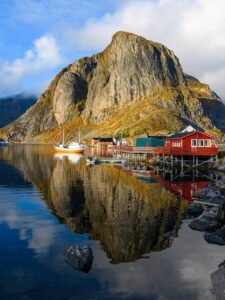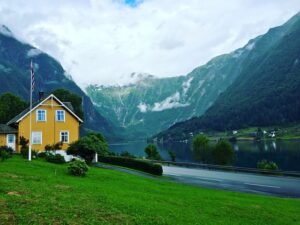

How to Use Onomatopoetic Words in Norwegian
Onomatopoeia, a captivating aspect of linguistics, involves words that phonetically mimic the sounds they describe. In Norwegian, as in many languages, onomatopoetic words can enrich communication by adding vividness and sensory detail. This comprehensive guide will delve into how to effectively use onomatopoetic words in Norwegian, enhancing your language skills and making your communication more dynamic and engaging.
Table of Contents
ToggleUnderstanding Onomatopoeia
The term “onomatopoeia” originates from the Greek words “onoma” (name) and “poiein” (to make), collectively meaning “the creation of a name (or word) from a sound.” Onomatopoetic words are indispensable in various forms of communication, particularly in literature, poetry, comics, and everyday speech, as they help convey sounds more realistically. These words bridge the gap between the auditory and the visual, allowing the reader or listener to “hear” the sounds described.
Common Norwegian Onomatopoetic Words
To effectively use onomatopoetic words, it’s crucial to familiarize yourself with some common examples in Norwegian. Here are several categories of onomatopoetic words, each illustrated with examples:
Dyrelyder (Animal Sounds)
- Mø (Moo): The sound a cow makes.
- Example: Kua sa “mø” da den så bonden. (The cow said “moo” when it saw the farmer.)
- Mjau (Meow): The sound a cat makes.
- Example: Katten mjauet høyt da den ville ha mat. (The cat meowed loudly when it wanted food.)
- Bjeff (Bark): The sound a dog makes.
- Example: Hunden bjeffet på fremmede. (The dog barked at strangers.)
- Kvakk (Quack): The sound a duck makes.
- Example: Endene kvakket ved dammen. (The ducks quacked by the pond.)
- Kykkeliky (Cock-a-doodle-doo): The sound a rooster makes.
- Example: Hanen gol “kykkeliky” ved daggry. (The rooster crowed “cock-a-doodle-doo” at dawn.)
- Pip (Peep): The sound a small bird makes.
- Example: Fuglen pep svakt i redet. (The bird peeped softly in the nest.)
- Vrinsk (Neigh): The sound a horse makes.
- Example: Hesten vrinsket da den så eieren sin. (The horse neighed when it saw its owner.)
- Kvekke (Croak): The sound a frog makes.
- Example: Froskene kvekket hele natten ved dammen. (The frogs croaked all night by the pond.)
Naturlyder (Nature Sounds)
- Summ (Buzz): The sound of a bee.
- Example: Biene summet rundt blomsten. (The bees buzzed around the flower.)
- Plask (Splash): The sound of water splashing.
- Example: Det var et stort plask da han hoppet i vannet. (There was a big splash when he jumped into the water.)
- Sus (Swoosh/Whoosh): The sound of the wind.
- Example: Vinden suste gjennom trærne. (The wind swooshed through the trees.)
- Dundre (Boom): The sound of thunder.
- Example: Tordenen dundret i det fjerne. (The thunder boomed in the distance.)
- Krak (Crack): The sound of wood breaking.
- Example: Greinen brakk med et høyt krak. (The branch broke with a loud crack.)
- Rasle (Rustle): The sound of leaves.
- Example: Løvet raslet under føttene våre. (The leaves rustled under our feet.)
- Plopp (Plop): The sound of a small object dropping into water.
- Example: Steinen laget et plopp da den falt i vannet. (The stone made a plop when it fell into the water.)
- Knitre (Crackle): The sound of fire.
- Example: Bålet knitret lystig i mørket. (The fire crackled cheerfully in the dark.)
- Drønn (Roar): The sound of ocean waves.
- Example: Bølgene drønnet mot klippene. (The waves roared against the cliffs.)
Menneskelige lyder (Human Sounds)
- Hikst (Hiccup): The sound of a hiccup.
- Example: Han hikstet etter å ha drukket for mye brus. (He hiccupped after drinking too much soda.)
- Nys (Sneeze): The sound of a sneeze.
- Example: Han nøs høyt i det stille rommet. (He sneezed loudly in the quiet room.)
- Gisp (Gasp): The sound of someone gasping.
- Example: Hun gispet av overraskelse. (She gasped in surprise.)
- Snufs (Sniffle): The sound of someone sniffing.
- Example: Barnet snufset da det gråt. (The child sniffled as it cried.)
- Buu (Boo): The sound of disapproval.
- Example: Publikum buet på den dårlige forestillingen. (The audience booed at the bad performance.)
- Sukk (Sigh): The sound of a sigh.
- Example: Hun sukket tungt av lettelse. (She sighed deeply with relief.)
Using Onomatopoetic Words in Sentences
Integrating onomatopoetic words into sentences can make your descriptions more vivid and engaging. Here are some practical examples:
Describing Animal Sounds
- Kua sa “mø” da den så bonden. (The cow said “moo” when it saw the farmer.)
- Katten mjauet høyt da den ville ha mat. (The cat meowed loudly when it wanted food.)
- Hunden bjeffet på fremmede. (The dog barked at strangers.)
- Endene kvakket ved dammen. (The ducks quacked by the pond.)
- Hanen gol “kykkeliky” ved daggry. (The rooster crowed “cock-a-doodle-doo” at dawn.)
- Fuglen pep svakt i redet. (The bird peeped softly in the nest.)
- Hesten vrinsket da den så eieren sin. (The horse neighed when it saw its owner.)
- Froskene kvekket hele natten ved dammen. (The frogs croaked all night by the pond.)
Describing Nature Sounds
- Biene summet rundt blomsten. (The bees buzzed around the flower.)
- Det var et stort plask da han hoppet i vannet. (There was a big splash when he jumped into the water.)
- Vinden suste gjennom trærne. (The wind swooshed through the trees.)
- Tordenen dundret i det fjerne. (The thunder boomed in the distance.)
- Greinen brakk med et høyt krak. (The branch broke with a loud crack.)
- Løvet raslet under føttene våre. (The leaves rustled under our feet.)
- Steinen laget et plopp da den falt i vannet. (The stone made a plop when it fell into the water.)
- Bålet knitret lystig i mørket. (The fire crackled cheerfully in the dark.)
- Bølgene drønnet mot klippene. (The waves roared against the cliffs.)
Describing Human Sounds
- Han hikstet etter å ha drukket for mye brus. (He hiccupped after drinking too much soda.)
- Han nøs høyt i det stille rommet. (He sneezed loudly in the quiet room.)
- Hun gispet av overraskelse. (She gasped in surprise.)
- Barnet snufset da det gråt. (The child sniffled as it cried.)
- Publikum buet på den dårlige forestillingen. (The audience booed at the bad performance.)
- Hun sukket tungt av lettelse. (She sighed deeply with relief.)
Enhancing Writing with Onomatopoeia
Onomatopoetic words can significantly enhance your writing, making it more immersive and engaging. Here are several strategies to incorporate these words effectively:
Use Contextually
Ensure that the onomatopoetic word fits naturally within the context of your sentence. Overusing these words can make your writing feel forced or juvenile. Use them sparingly and only when they add value to your description.
Combine with Descriptive Language
Pair onomatopoetic words with other descriptive language to create a more vivid picture. For instance, instead of simply saying, “It was raining,” you could say, “Regnet trommet på taket mens vinden suste gjennom trærne.” (The rain drummed on the roof while the wind swooshed through the trees.)
Use in Dialogue
Onomatopoetic words can add authenticity to dialogue, especially in storytelling. For example:
- “Hørte du det braket?” spurte han. (Did you hear that crash? he asked.)
- “Katten mjauet hele natten,” klaget hun. (The cat meowed all night, she complained.)
Create Atmosphere
Onomatopoetic words are excellent for setting the scene and creating atmosphere. In a suspenseful scene, the sound of footsteps (tramp) or a creaking door (knirk) can heighten tension:
- “Han hørte knirkingen av døra og visste at noen var der.” (He heard the creaking of the door and knew someone was there.)
Conclusion
Onomatopoetic words are a powerful tool in the Norwegian language, adding an extra layer of sensory detail to your communication. By understanding and practicing these words, you can make your speech and writing more engaging and vivid. Whether describing the mø of a cow, the sus of the wind, or the plask of a splash, onomatopoeia will help you bring your words to life. Embrace these words, and watch your Norwegian language skills flourish as you paint more vivid and immersive pictures with your descriptions.
If you want to learn Norwegian, you can register for classes here. We look forward to hearing from you and helping you become fluent in Norwegian.





